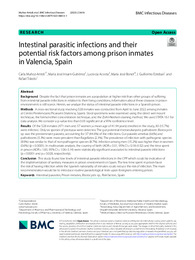Por favor, use este identificador para citar o enlazar este ítem:
https://hdl.handle.net/11000/34388Registro completo de metadatos
| Campo DC | Valor | Lengua/Idioma |
|---|---|---|
| dc.contributor.author | Muñoz-Antoli, Carla | - |
| dc.contributor.author | Irisarri Gutiérrez, Maria José | - |
| dc.contributor.author | Acosta Soto, Lucrecia | - |
| dc.contributor.author | Bonet, María José | - |
| dc.contributor.author | Esteban, José Guillermo | - |
| dc.contributor.author | Toledo, Rafael | - |
| dc.contributor.other | Departamentos de la UMH::Agroquímica y Medio Ambiente | es_ES |
| dc.date.accessioned | 2025-01-11T16:17:53Z | - |
| dc.date.available | 2025-01-11T16:17:53Z | - |
| dc.date.created | 2023-09-19 | - |
| dc.identifier.citation | BMC Infectious Diseases volume 23, Article number: 616 (2023) | es_ES |
| dc.identifier.issn | 1471-2334 | - |
| dc.identifier.uri | https://hdl.handle.net/11000/34388 | - |
| dc.description.abstract | Background: Despite the fact that prison inmates are a population at higher risk than other groups of suffering from intestinal parasite infections in relation to their living conditions, information about these diseases in prison environments is still scarce. Herein, we analyze the status of intestinal parasite infections in a Spanish prison. Methods: A cross-sectional study involving 528 inmates was conducted from April to June 2022 among inmates at Centro Penitenciario Picassent (Valencia, Spain). Stool specimens were examined using the direct wet mount technique, the formol-ether concentration technique, and the Ziehl-Neelsen staining method. We used STATA 16.1 for data analysis. We consider a p-value less than 0.05 significant at a 95% confidence level. Results: Of the 528 inmates (471 men and 57 women; a mean age of 41.94 years) enrolled in the study, 83 (15.7%) were infected. Only six species of protozoa were detected. The gut potential microeukaryotic pathobiont Blastocystis sp. was the predominant parasite, accounting for 37 (44.6%) of the infections. Gut parasite amebas (6.6%) and pathobionts (5.3%) were more prevalent than flagellates (2.3%). The prevalence of infection with pathogenic species (8.9%) was similar to that of non-pathogenic species (8.7%). Infection among men (15.2%) was higher than in women (0.6%) (p < 0.0001). In multivariate analysis, the country of birth (AOR = 0.31, 95% CI = 0.18–0.52) and the time spent in prison (AOR = 1.83, 95% CI = 1.06–3.14) were statistically significant associated to intestinal parasite infections (p < 0.0001 and p = 0.028, respectively). Conclusion: This study found low levels of intestinal parasite infections in the CPP which could be indicative of the implementation of sanitary measures in prison environments in Spain. The less time spent in prison favor the risk of having infection while the Spanish nationality of inmates could reduce the risk of infection. The main recommendation would be to introduce routine parasitological tests upon foreigners entering prison | es_ES |
| dc.format | application/pdf | es_ES |
| dc.format.extent | 7 | es_ES |
| dc.language.iso | eng | es_ES |
| dc.publisher | BioMed Central | es_ES |
| dc.rights | info:eu-repo/semantics/openAccess | es_ES |
| dc.rights | Attribution-NonCommercial-NoDerivatives 4.0 Internacional | * |
| dc.rights.uri | http://creativecommons.org/licenses/by-nc-nd/4.0/ | * |
| dc.subject | Intestinal parasites | es_ES |
| dc.subject | Prison inmates | es_ES |
| dc.subject | Blastocystis sp. | es_ES |
| dc.subject | Risk factors | es_ES |
| dc.subject | Spain | es_ES |
| dc.title | Intestinal parasitic infections and their potential risk factors among prison inmates in Valencia, Spain | es_ES |
| dc.type | info:eu-repo/semantics/article | es_ES |
| dc.relation.publisherversion | https://doi.org/10.1186/s12879-023-08613-1 | es_ES |

Ver/Abrir:
Intestinal parasitic infections and their potential risk factors among prison inmates in Valencia.pdf
937,15 kB
Adobe PDF
Compartir:
 La licencia se describe como: Atribución-NonComercial-NoDerivada 4.0 Internacional.
La licencia se describe como: Atribución-NonComercial-NoDerivada 4.0 Internacional.
.png)